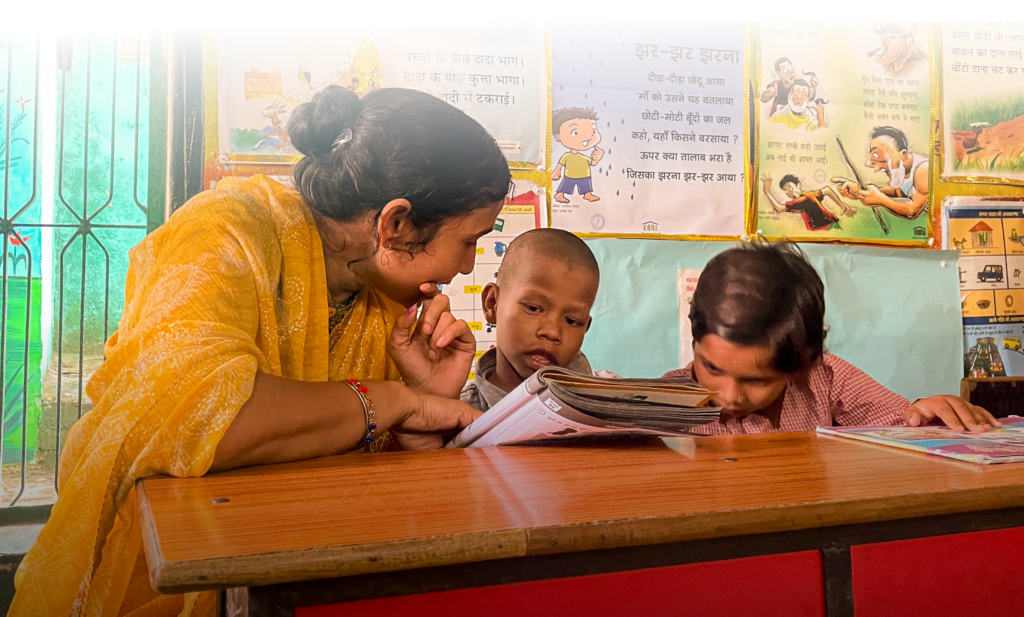System Strengthening
We can solve the learning crisis by working to strengthen the government education system.
We support state governments in developing high-quality teaching and learning materials, improve training quality, and build their capacity for working on these dimensions independently.
16.2 million
Students Reached
8 States
MOUs with state governments. of Assam, Chhattisgarh, Jharkhand, Haryana, Odisha, Rajasthan, Tripura and Uttar Pradesh
860,000
Teachers Reached
OVERVIEW
Achieving impact at scale requires systems at state and district levels to change
We strengthen government institutions in developing and implementing these statewide solutions. We build capacity through workshops, training programs, and the demonstration of good practices to ensure that state agencies can work on FLN solutions on their own.
WE HAVE SUPPORTED STATE GOVERNMENTS IN 3 WAYS
State-wide Teacher Training
With government institutions, we co-create an annual teacher professional development plan, which includes:
- Short online courses
- Face-to-face workshops
- Monthly cluster-level peer meetings
- WhatsApp-based resources.
We support state governments in reform initiatives like developing improved pre-service teacher education programs using data at all levels to:
- Help improve FLN program implementation
- Build the capacity of state institutions like the State Council of Educational Research and Training (SCERT), the District Institute of Education and Training (DIET), and State Resource Groups.
Classroom Teaching and Learning Material
With our support, state governments have developed classroom teaching and learning materials including:
- Workbooks for students –Help 16.2 million children practice newly learned concepts and skills.
- Teacher guides and handbooks – Provide clear and targeted daily lesson plans that help 856,000 teachers teach in a structured manner.
- Print rich materials for classrooms – Create conversation charts, picture story/poem posters in classrooms for children’s active interaction.
Training the Trainers/ Mentors
We co-create tools and methods that help mentors support teachers by:
- Conducting classroom observations and share meaningful and specific feedback with teachers to help them improve teaching practices
We create a comprehensive, school-focused assessment architecture that includes competency-based assessment to help teachers identify gaps in learning and strategize child-centric solutions for learning improvement.

STORIES FROM THE FIELD
Co-created materials have changed the way teachers have approached their curriculum.
Since introducing the Teacher Guide in Uttar Pradesh, Head Teacher Satyendra Tripathi from Rameshwar First Primary School in Varanasi began to approach teaching the curriculum in a very different way.
He says, “Previously, teachers would follow textbooks in a linear manner. This method meant that they taught concepts in the same order that was within the book. If students missed any classes, it was difficult for them to catch up with the rest of the class. Since lessons were taught without a clear plan and structure, it was harder for them to revisit a concept that was taught earlier. Now, there is ample opportunity for students to revisit and revise earlier concepts as they are all interconnected
The revised curriculum allows for multiple checks for understanding, which is very different from linear format rote learning. It has helped teachers and students understand and master the topics and content.
Our teachers go through 4-5 day intensive training to learn to use the teaching guide. This training gives us a lot of clarity on what to teach, when, and how. We are able to ensure students are actually understanding the concepts being taught instead of rote memorization since the lessons in the guide also include activities for students.”
Language is the base for all learning, and therefore, the major focus of primary grades should be to develop strong language skills in children. This course provides teachers with many ways to develop language and literacy skills without a prescriptive design. Teachers are left with the decision about which strategies and activities are best suited to their classroom children and situation.
Mr. Vijay Kiran Anand Director General, School Education, Government of Uttar PradeshDiscussion forums, calls, project work, self-reading, and self-assessment kept us busy throughout the course, giving us the opportunity to expand our understanding. Behind all of this training is efficient management, thorough research, use of technology, and the complete dedication of the LLF team. The course has also helped me to influence language teaching of fellow teachers in the district through professional learning communities.
Dr. M. Sudhish Assistant Director, Sarva Shiksha Abhiyan, ChhattisgarhUP has made big strides in the implementation of the National Initiative for Proficiency in Reading with Understanding and Numeracy (NIPUN) Bharat. LLF's support to SCERT and Samagra Shiksha has been instrumental in developing workbooks and teacher guides, which are being used by teachers and children in 113,000 primary schools. The teacher guides developed with LLF support give direction to teachers on what to teach, when, and how. This training helps students to grasp concepts better than by mere rote learning. Moreover, teacher training organised with LLF support is helping teachers master teaching techniques, a change which is beginning to improve learning outcomes in classrooms. The resource materials shared in the course are useful for my classroom. There are good readings and videos. I liked the self-evaluation part in the modules, which helps to evaluate myself and confirm my understanding.
Mr. Akhileshwar Prasad Gupta Assistant Coordinator, Varanasi District, Uttar Pradesh
2030 MISSION
By 2030, we will reach 35 million children by influencing classroom practices of more than 2 million teachers and teacher educators
Your support can help us achieve this mission

